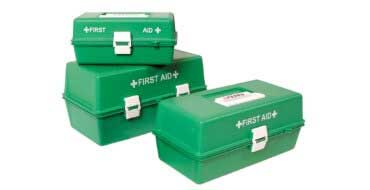What Should Be Included In A First Aid Kit?

Your first aid kit should be organised, properly stocked and available at all times. It’s a good idea to have a first aid kit in various locations such as at home, in the car and at work. You can buy first aid kits from your pharmacy or from providers. Specialty kits are also available to meet specific needs.
It is strongly recommended that you participate in a first aid course so you will have the knowledge and skills to use equipment in a first aid kit to help someone who is suddenly injured or becomes ill.
Contents Of A Basic First Aid Kit
First aid kit contents vary according to their particular use. For example, a first aid kit for a farm will contain a few different items to a first aid kit for a city-dwelling family.
A basic first aid kit should contain:
- Triangular bandages
- Crepe (‘conforming’ or elastic) bandages of varying widths
- Non-adhesive (non-stick) dressings of varying sizes
- Disposable gloves (medium and large), preferably made of non-latex material
- Thermal blanket
- Notepad and pencil
- Plastic bags of varying sizes
- Adhesive tape (2.5 cm wide – preferably a permeable tape such as Micropore)
- Resuscitation mask or face shield.
Other equipment can include:
- Medium combine dressing pads (9 x 20 cm)
- Large combine dressing pads (20 x 20 cm)
- Adhesive dressing strips (bandaids)
- Medium gauze dressing (7.5 x 7.5 cm)
- Four sterile tubes of saline solution (minimum 10 ml)
- One pair of scissors
- One pair of tweezers
- First aid booklet.
Medications In First Aid Kits
The First Aid in the Workplace Code of Practice advises that first aid kits for workplaces should not contain medications. First aid is defined as the provision of emergency treatment and life support for people suffering injury or illness. The dispensing of medication does not generally fall within this definition. It is recommended that medicines are not kept in a first aid kit.
If you keep medicines for yourself or your family, such as paracetamol and aspirin for pain relief, they should be kept secure and out of reach of children.
Storing Your First Aid Kit
Storage suggestions include:
- Keep the first aid kit in a dry, cool location
- Make sure the first aid kit is easily accessible and that everyone in the family knows where it is
- Some items, such as solutions, may have use-by dates. Check regularly and replace when necessary
- If an item is used from the first aid kit, promptly replace it
- Automatic self-check
Things To Remember
- Keep a first aid kit at home, in the car and at work
- You can purchase first aid kits from your local pharmacy or from providers
- Do a first aid course, so you know how to help if someone is injured or becomes ill
For further information, please refer to First Aid Government guidelines, or book onto one of our First Aid courses!
